Sikorsky UH-60 Black Hawk Video - Picture
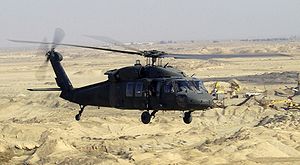
|
|
Sikorsky UH-60 Black Hawk
UH-60 Black Hawk

Picture - A UH-60L Black Hawk flies a low-level mission over Iraq in 2004.
Role: Utility helicopter
Manufacturer: Sikorsky Aircraft Corporation
First flight: 29 November 1974
Introduced: 1979
Status: Active service
Primary users: United States Army
Republic of Korea Army
Colombian Armed Forces
Turkish Armed Forces
Produced: 1974-present
Number built: >2,600
Unit cost: US$44 million (avg. cost fully equipped, 2008)
Variants: Sikorsky SH-60 Seahawk
Sikorsky HH-60 Pave Hawk
Sikorsky HH-60 Jayhawk
Sikorsky S-70
The UH-60 Black Hawk is a four-bladed, twin-engine, medium-lift utility helicopter manufactured by Sikorsky Aircraft. Sikorsky submitted the S-70 design for the United States Army's Utility Tactical Transport Aircraft System (UTTAS) competition in 1972. The Army designated the prototype as the YUH-60A and selected the Black Hawk as the winner of the program in 1976, after a fly-off competition with the Boeing Vertol YUH-61.
The UH-60A entered service with the Army in 1979, to replace the Bell UH-1 Iroquois as the Army's tactical transport helicopter. This was followed by the fielding of electronic warfare and special operations variants of the Black Hawk. Improved UH-60L and UH-60M utility variants have also been developed. Modified versions have also been developed for the U.S. Navy and U.S. Air Force. In addition to U.S. Army use, the UH-60 family has been exported to several nations. Black Hawks have served in combat during conflicts in Grenada, Panama, Iraq, Somalia, the Balkans, Afghanistan, and other areas in the Middle East.
Development
Initial requirement
In the late 1960s, the United States Army began forming requirements for a helicopter to replace the UH-1 Iroquois, and designated the program as the Utility Tactical Transport Aircraft System (UTTAS). The Army also initiated the development of a new, common turbine engine for its helicopters that would become the General Electric T700. Based on experience in Vietnam, the Army required significant performance, survivability and reliability improvements from both UTTAS and the new powerplant. The Army released its UTTAS request for proposals (RFP) in January 1972. The RFP also included air transport requirements. Transport aboard the C-130 limited the UTTAS cabin height and length.
The UTTAS requirements for improved reliability, survivability and lower life-cycle costs resulted in features such as dual-engines with improved hot and high altitude performance, and a modular design (reduced maintenance footprint); run-dry gearboxes; ballistically tolerant, redundant subsystems (hydraulic, electrical and flight controls); crashworthy crew (armored) and troop seats; dual-stage oleo main landing gear; ballistically tolerant, crashworthy main structure; quieter, more robust main and tail rotor systems; and a ballistically tolerant, crashworthy fuel system.
Four prototypes were constructed, with the first YUH-60A flying in October 1974. Prior to delivery of the prototypes to the US Army, a preliminary evaluation was conducted in November 1975 to ensure the aircraft could be operated safely during all testing. Three of the prototypes were delivered to the Army in March 1976, for evaluation against the rival Boeing-Vertol design, the YUH-61A, and one was kept by Sikorsky for internal research. The Army selected the UH-60 for production in December 1976. Deliveries of the UH-60A to the Army began in October 1978 and the helicopter entered service in June 1979.
Upgrades and variations
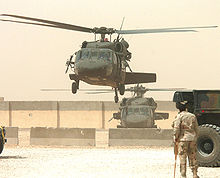
Picture - UH-60s equipped with M60 machine guns near An Najaf, Iraq in May 2005.
After entering service, the helicopter was modified for new missions and roles, including mine laying and medical evacuation. An EH-60 variant was developed to conduct electronic warfare and special operations aviation developed the MH-60 variant to support its missions.
Due to weight increases from the addition of mission equipment and other changes, the Army ordered the improved UH-60L in 1987. The new model incorporated all of the modifications made to the UH-60A fleet as standard design features. The UH-60L also featured more power and lifting capability with upgraded T700-GE-701C engines and a stronger gearbox, both developed for the SH-60B Seahawk. Its external lift capacity increased by 1,000 lb (450 kg) to 9,000 lb (4,100 kg). The UH-60L also incorporated the automatic flight control system (AFCS) from the SH-60 for better flight control due to handling issues with the more powerful engines. Production of the L-model began in 1989.
Development of the next improved variant, the UH-60M, was approved in 2001, to extend the service life of the UH-60 design into the 2020s. The UH-60M incorporates upgraded T700-GE-701D engines and improved rotor blades. It also features state of the art electronic instrumentation, flight controls and aircraft navigation control. After the U.S. DoD approved low-rate initial production of the new variant, manufacturing began in 2006, with the first of 22 new UH-60Ms delivered in July 2006. After an initial operational evaluation, the Army approved full-rate production and a five-year contract for 1,227 helicopters in December 2007. By March 2009, 100 UH-60M helicopters had been delivered to the Army.
In the 1 May 2011 operation that killed Osama bin Laden, it emerged that the 160th Special Operations Aviation Regiment, which operated the helicopters during the raid, used a heavily modified version of the UH-60. Features apparently include a modified tail section with extra blades on the tail rotor and other additions which significantly lower noise levels from that of conventional UH-60s. It also had low-observable technology similar to that of F-117 that enabled it to evade Pakistan Air Force radars. The aircraft seemed to include features like special high-tech materials, harsh angles, and flat surfaces, found only on sophisticated stealth jets. This came to light only when one of the helicopters used in the operation crashed and was subsequently destroyed except for its tail section.
Design
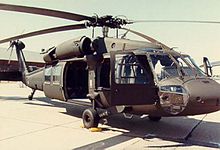
Picture - UH-60A Black Hawk parked on flight line
The UH-60 features a four-blade main and tail rotors and is powered by two General Electric T700 turboshaft engines. It has a long, low profile shape to meet the Army's requirement for transporting aboard a C-130 Hercules. It can carry 11 troops with equipment, lift 2,600 lb (1,170 kg) of cargo internally or 9,000 lb (4,050 kg) of cargo (for UH-60L/M) externally by sling.
The Black Hawk helicopter series can perform a wide array of missions, including the tactical transport of troops, electronic warfare, and aeromedical evacuation. A VIP version known as the VH-60N is used to transport important government officials (e.g., Congress, Executive departments) with the helicopter's call sign of "Marine One" when transporting the President of the United States. In air assault operations it can move a squad of 11 combat troops or reposition a 105 mm M102 howitzer with thirty rounds ammunition, and a four-man crew in a single lift. The Black Hawk is equipped with advanced avionics and electronics for increased survivability and capability, such as the Global Positioning System.
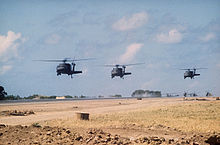
Picture - UH-60A Black Hawks over Port Salinas during the invasion of Grenada, 1983. The conflict saw the first use of the UH-60.
The UH-60 can be equipped with stub wings at top of fuselage to carry fuel tanks or various armaments. The initial stub wing system is called External Stores Support System (ESSS). It has two pylons on each wing to carry two 230 US gal (870 L) and two 450 US gal (1,700 L) tanks in total. The four fuel tanks and associated lines and valves form the external extended range fuel system (ERFS). The ESSS can also carry 10,000 lb (4,500 kg) of armament such as rockets, missile and gun pods. The ESSS entered service in 1986. However it was found that with four fuel tanks it would obstruct the firing field of the door guns. To alleviate the issue, the external tank system (ETS) with unswept stub wings to carry two fuel tanks was developed.
The unit cost varies with the version due to the varying specifications, equipment and quantities. For example, the unit cost of the Army's UH-60L Black Hawk is $5.9 million while the unit cost of the Air Force MH-60G Pave Hawk is $10.2 million.
Operational history
U.S. Army
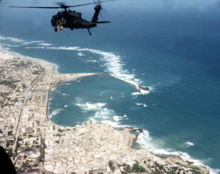
Picture - U.S. Army MH-60L during the Battle of Mogadishu
The UH-60 entered service with the U.S. Army's 101st Combat Aviation Brigade of the 101st Airborne Division in June 1979. The U.S. military first used the UH-60 in combat during the invasion of Grenada in 1983, and again in the invasion of Panama in 1989. During the Gulf War in 1991, the UH-60 participated in the largest air assault mission in U.S. Army history with over 300 helicopters involved. In 1993, Black Hawks featured prominently in the assault on Mogadishu in Somalia. Black Hawks also saw action in the Balkans and Haiti in the 1990s.
Army UH-60s and other helicopters conducted many air assault and other support missions during the 2003 invasion of Iraq. The UH-60 continues to serve in operations in Afghanistan and Iraq. Highly-modified H-60s were employed during the US Special Forces operation that resulted in the death of Osama bin Laden on 1 May 2011. One such helicopter experienced mechanical trouble during the operation and the team was forced to destroy it before departing. The team members later departed in one of two MH-47 Chinooks with bin Laden's remains. Two MH-47s were used for the mission to refuel the two MH-60s and as backups.
Colombia
Colombia first received UH-60s from the United States in 1987. The Colombian National Police, Colombian Air Force, and Colombian Army use UH-60s to mobilize troops and supplies to places which are difficult to access by ground for counter-insurgency (COIN) operations against drug and guerrilla organizations, as well as for search & rescue and medical evacuation. Colombia also has a militarized gunship version of the UH-60, with stub wings, locally known as Arpxa (English: Harpy).
Israel
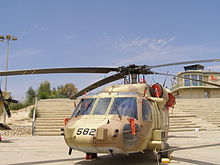
Picture - Israel Air Force UH-60 Black Hawk (Yanshuf)
The Israeli Air Force (IAF) received 10 surplus UH-60A Black Hawks from the United States in August 1994. Nicknamed Yanshuf (English: Owl), the UH-60A began replacing Bell 212 utility helicopters of the Israeli Defense Forces. The IAF first used the UH-60s in combat in April 1996, during operation "Grapes of Wrath" against the Hizbullah in southern Lebanon.
In March 2000, three IAF UH-60s were used to ferry Pope John Paul II during his visit to Israel, with one helicopter carrying the Pope, another his medical team and a third available on constant standby. The IAF had 49 UH-60s in operation as of November 2008.
Mexico
The Mexican Air Force ordered its first two UH-60Ls in 1991, to transport special forces units, and since then purchased another 4 in 1994. In March 2009, the United States stated it would provide discounted helicopters and other equipment under the Mérida Initiative, to fight the drug cartels in the Mexican drug war. In July and August 2009, the Federal Police used UH-60s in attacks on drug traffickers. In 2010, the Mexican Navy ordered three UH-60Ms.
Republic of China (Taiwan)
Taiwan has operated S-70C-1/1A since the ROC Air Force received ten S-70C-1A and four S-70C-1 Bluehawk helicopters in June 1986 for Search And Rescue. Four further S-70C-6s were received in April 1998. The ROC Navy received the first of ten S-70C(M)-1s in July 1990. 11 S-70C(M)-2s were received beginning April 2000. In January 2010, the US announced a Foreign Military Sale of 60 UH-60Ms to Taiwan for the ROC Army.
Turkey
Turkey has operated the UH-60 during NATO deployments to Afghanistan and the Balkans. The UH-60 has also been used in counter-terror/internal security operations.
The Black Hawk competed in the Turkish General Use Helicopter Tender against the AgustaWestland AW149. Under this project Turkey intends to order up to 115 helicopters and produce many of them indigenously. Turkish Aerospace Industries will be responsible for the final integration and assembly. On 21 April 2011, Turkey announced the selection of Sikorsky's T-70 for the tender.
Other and potential users
The United Arab Emirates has received 20 UH-60Ls by November 2010. The nation requested 14 UH-60M helicopters in September 2008 through a Foreign Military Sale. The package includes laser and radar warning sensors as well as weapons systems.
Brazil has requested 15 additional UH-60Ls through a Foreign Military Sale in 2008.
Sweden requested 15 UH-60Ms by a Foreign Military Sale in September 2010. On 9 April 2011, Swedish Minister for Defence Sten Tolgfors announced that the negotiations are almost finalized. Helicopter deliveries are to start in 2012. Swedish pilots will begin training on the helicopter this summer. The UH-60M helicopters are be fully operational by 2017.
Variants
The UH-60 comes in many variants, and many different modifications. The U.S. Army variants can be fitted with the stub wings to carry additional fuel tanks or weapons. Variants may have different capabilities and their respective equipment in order to fulfill different roles.
Utility variants
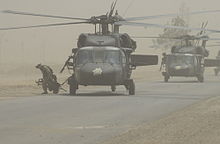
Picture - UH-60L from B Company ("Lancers"), 5th Battalion, 101st Aviation Regiment, on an air assault mission in Iraq
YUH-60A: The initial test and evaluation version. First flight on 17 October 1974; three built.
UH-60A Black Hawk: Original U.S. Army version, carrying a crew of four and up to 11 equipped troops. Equipped with T700-GE-700 engines. Produced 1977-1989.
UH-60C Black Hawk: Modified version for Command and control (C2) missions.
CH-60E: Proposed troop transport variant for the US Marine Corps.
UH-60L Black Hawk: UH-60A with upgraded T700-GE-701C engines, improved durability gearbox, and updated flight control system. Produced 1989-2007. UH-60Ls are also being equipped with the GE T700-GE-701D engine.
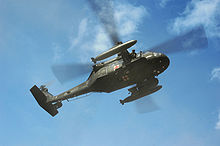
Picture - US Army UH-60A MEDEVAC evacuating simulated casualties during a training exercise
UH-60M Black Hawk: Improved design wide chord rotor blades, T700-GE-701D engines (max 2,000 shp/1,500 kW each), improved durability gearbox, Integrated Vehicle Management Systems (IVHMS) computer, and the Common Avionics Architecture System (CAAS) flight instrument suite. Production began in 2006. Planned to replace older U.S. Army UH-60s.
UH-60M Upgrade Black Hawk: UH-60M with fly-by-wire system and Common Avionics Architecture System (CAAS) flight system. Flight testing began in August 2008.
Special purpose
EH-60A Black Hawk: UH-60A with modified electrical system and stations for two electronic systems mission operators. All examples of type have been converted back to standard UH-60A configuration.
YEH-60B Black Hawk: UH-60A modified for special radar and avionics installations, prototype for stand-off target acquisition system.
EH-60C Black Hawk: UH-60A modified with special electronics equipment and external antenna. (All examples of type have been taken back to standard UH-60A configuration.)
EUH-60L (no official name assigned): UH-60L modified with additional mission electronic equipment for Army Airborne C2.
EH-60L Black Hawk: EH-60A with major mission equipment upgrade.
UH-60Q Black Hawk: UH-60A modified for medical evacuation. The UH-60Q is named DUSTOFF for "dedicated unhesitating service to our fighting forces".
HH-60L (no official name assigned): UH-60L extensively modified with medical mission equipment. Components include an external rescue hoist, integrated patient configuration system, environmental control system, on-board oxygen system (OBOGS), and crashworthy ambulatory seats.
HH-60M Black Hawk: US Army variant. UH-60M with medical mission equipment (medevac version). Also has no gunner's windows, and includes a nose mounted FLIR.
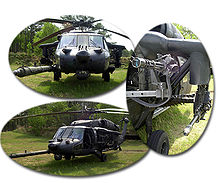
Picture - MH-60L Direct Action Penetrator (DAP)
MH-60A Black Hawk: US Army variant. 30 UH-60As modified with additional avionics, night vision capable cockpit, FLIR, M134 door guns, internal axillary fuel tanks and other Special Operations mission equipment in early 1980s. Equipped with T700-GE-701 engines. Variant was used by the 160th Special Operations Aviation Regiment. The MH-60As were replaced by MH-60Ls beginning in the early 1990s and passed to the Air National Guard.
MH-60K Black Hawk: US Army variant. Special operations modification first ordered in 1988 for use by the 160th Special Operations Aviation Regiment ("Night Stalkers"). Equipped with the in-flight refueling probe, and T700-GE-701C engines. More advanced than MH-60L, the K-model also includes an integrated avionics system (glass cockpit), AN/APQ-174B terrain-following radar, color weather map generator, improved weapons capability, and various defensive systems.
MH-60L Black Hawk: US Army variant. Special operations modification, used by the 160th Special Operations Aviation Regiment ("Night Stalkers"), based on the UH-60L with T700-701C engines. It was developed as an interim version in the late 1980s pending fielding of the MH-60K. Equipped with many of the systems used on MH-60K, including FLIR, terrain-following radar, color weather map generator, auxiliary fuel system, and laser rangefinder/designator. 37 MH-60Ls were built and some 10 had received a in-flight refueling probe by 2003.
MH-60L Direct Action Penetrator (DAP): US Army variant. Special operations modification of the baseline MH-60L, operated by the 160th Special Operations Aviation Regiment. The DAP is equipped with ESSS or ETS stub wings, each capable of carrying a M230 Chain Gun 30 mm automatic cannon, rocket pods, and various other armaments. M134D miniguns are used as door guns.
MH-60M Black Hawk: US Army variant. Special operations version of UH-60M. It will feature the Rockwell Collins Common Avionics Architecture System (CAAS) glass cockpit and more powerful YT706-GE-700 engines.
MH-60 Black Hawk stealth helicopter: One of two specially modified MH-60s used in the raid on Osama bin Laden's hideout in Pakistan on 1 May 2011 was damaged in a hard landing, and was subsequently destroyed by US forces. Subsequent reports state that the Blackhawk destroyed was a previously unconfirmed, but rumored, modification of the design with reduced noise signature and stealth technology. The modifications are said to add several hundred pounds to the base helicopter including edge alignment panels, special coatings and anti-radar treatments for the windshields.
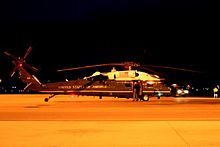
Picture - VH-60N used to transport the President of the United States
UH-60A RASCAL: NASA-modified version for the Rotorcraft-Aircrew Systems Concepts Airborne Laboratory: $US25M program for the study of helicopter maneuverability in three programs, Superaugmented Controls for Agile Maneuvering Performance (SCAMP), Automated Nap-of-the-Earth (ANOE) and Rotorcraft Agility and Pilotage Improvement Demonstration (RAPID).
VH-60D Nighthawk: USMC variant. VIP-configured HH-60D, used for Presidential transport. T700-GE-401C engines. Variant was later redesignated VH-60N.
VH-60N Whitehawk: USMC variant. Modified UH-60A with some features from the SH-60B/F Seahawks. Used for Presidential and VIP transport. It entered service in 1988 and nine were delivered.
Export versions
UH-60J Black Hawk: Variant for the Japanese Air Self Defense Force and Maritime Self Defense Force produced under license by Mitsubishi Heavy Industries. Also known as the S-70-12.
UH-60JA Black Hawk: Variant for the Japanese Ground Self Defense Force. It is license produced by Mitsubishi Heavy Industries.
AH-60L Arpxa III: Export version for Colombia. It is COIN attack version with improved electronics, firing system, FLIR, radar, light rockets and machine gun. It was developed by Elbit, Sikorsky, and the Colombian Air Force.
AH-60L Battle Hawk: Export version unsuccessfully tendered for Australian Army project AIR87, similar to AH-60L Arpxa III.
UH-60P Black Hawk: Version for the Republic of Korea, based on UH-60L with some improvements. Around 150 were produced domestically by Korean Air.
S-70A
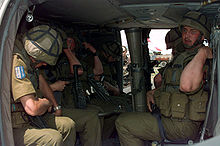
Picture - Norwegian soldiers in a UH-60
Sikorsky military model for the export market:
S-70A-1 Desert Hawk: Export version for the Royal Saudi Land Forces.
S-70A-L1 Desert Hawk: Aeromedical evacuation version for the Royal Saudi Land Forces.
S-70-5 Black Hawk: Export version for the Philippine Air Force.
S-70-6 Black Hawk: Export version for Thailand.
S-70A-9 Black Hawk: Export version for Australia, assembled under licence by Hawker de Havilland. First eight delivered to the Royal Australian Air Force, subsequently transferred to the Australian Army; remainder delivered straight to the Army after rotary-wing assets divested by the Air Force in 1989.
S-70-11 Black Hawk: Export version for the Royal Jordanian Air Force.
S-70-12 Black Hawk: Search and rescue model for the Japanese Air Self Defense Force and Maritime Self Defense Force. Also known as the UH-60J.
S-70-14 Black Hawk: Export version for Brunei.
S-70-16 Black Hawk: Engine test bed for the Rolls-Royce/Turbomeca RTM 332.
S-70-17 Black Hawk: Export version for Turkey.
S-70-18 Black Hawk: UH-60P and HH-60P for Republic of Korea built under license.
Sikorsky/Westland S-70-19 Black Hawk: This version is built under license in the United Kingdom by Westland. Also known as the WS-70.
S-70-20 Black Hawk: VIP transport version for Thailand.
S-70-21 Black Hawk: Export version for Egypt.
S-70-22 Black Hawk: VH-60P for Republic of Korea built under license. Used for VIP transport by the Republic of Korea Air Force. Its fuselage is tipped with white to distinguish from normal HH-60P.
S-70-24 Black Hawk: Export version for Mexico.
S-70-26 Black Hawk: Export version for Morocco.
S-70-27 Black Hawk: Search and rescue version for the Hong Kong Government Flying Service; three built.
S-70A-30 Black Hawk: Export version for Argentine Air Force, used as a VIP transport helicopter by the Presidential fleet; one built.
S-70A-39 Black Hawk: VIP transport version for Chile; one built.
S-70A-42 Black Hawk: Export version for Austria.
S-70A-43 Black Hawk: Export version for Royal Thai Army.
S-70A-50 Black Hawk: Export version for Israel; 15 built.
See Sikorsky SH-60 Seahawk, Sikorsky HH-60 Pave Hawk, and Sikorsky HH-60 Jayhawk for other Sikorsky S-70 variants.
Military operators
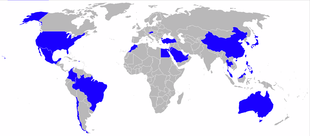
Picture - UH-60 Black Hawk Operators
Australia
Australian Army Aviation has 35 S-70A-9 Black Hawks in service as of January 2010.
5th Aviation Regiment (Australia)
B Squadron
6th Aviation Regiment (Australia)
171st Aviation Squadron (Australia)
Austria
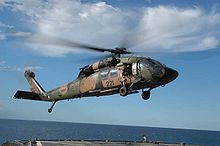
Picture - An Australian Army S-70A-9 Black Hawk
Austrian Air Force has 9 S-70A-42 Black Hawk as of January 2010.
Bahrain
Received 2 UH-60A/S-70A and 8 UH-60L/S-70A Black Hawks.
Brazil
Brazilian Air Force has 10 UH-60s in service. Brazil requested another 15 in September 2008.
Brazilian Army has 4 UH-60Ls in service with another 6 on order as of November 2008.
Brazilian Navy (see SH-60 Seahawk)
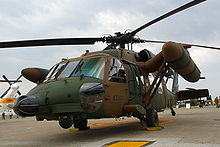
Picture - Japan Ground Self-Defense Force UH-60J
Brunei
Royal Brunei Air Force has received 1 UH-60A and 1 UH-60L Black Hawks with 9 UH-60Ms on order as of 2007.
Colombia
Colombian Air Force has 32 UH-60A/L and AH-60L Arpia III in use as of November 2008.
Colombian Army has 34 UH-60A/L with 15 more on order as of November 2008.
Colombian National Police has 7 in use in August 2010.
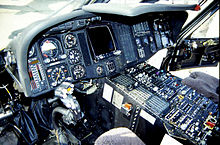
Picture - A cockpit view of a UH-60
Chile
Received 1 UH-60L.
Egypt
Received 8 UH-60Ls, with 4 in service as of Nov. 2008. 62 UH-60Ms have been ordered with deliveries in 2011-2013.
Israel
Has 49 S-70A/UH-60A/L helicopters in use as of Nov. 2008.
Japan
Japan Air Self-Defense Force has 31 UH-60s in service as of Nov. 2008.
Japan Maritime Self-Defense Force (see Mitsubishi H-60 for details)
Japan Ground Self-Defense Force has 27 UH-60s in service with 1 on order as of Nov. 2008.
Jordan
Has 9 UH-60Ls in service with 2 on order as of Nov. 2008.
Republic of Korea
The Republic of Korea Army and Navy received 130 and 10 UH-60P Black Hawks, respectively. Republic of Korea has 141 S-70A/UH-60P helicopters in use as of November 2008. The Republic of Korea Air Force has 10 VH-60P and HH-60P helicopters.
Malaysia
Royal Malaysian Air Force received 2 UH-60L (S-70A) Black Hawks for VIP transport.
Morocco
Royal Moroccan Police Air Squadron received 2 UH-60Ls for VIP transport.
Mexico
Mexican Air Force received 6 UH-60L (S-70A-24) Black Hawks.
Mexican Federal Police
Philippines
Philippine Air Force Presidential Air Wing received 2 UH-60A (S-70A) helicopters.
People's Republic of China
People's Liberation Army Air Force has 22 S-70Cs in inventory as of November 2008.
Republic of China (Taiwan)
Republic of China Air Force has 17 S-70Cs in service as of November 2008.
Republic of China Navy (see SH-60 Seahawk)
Republic of China Army has requested 60 UH-60Ms.
Saudi Arabia
Has 15 UH-60Ls in use as of November 2008.
Thailand
Royal Thai Army has 7 UH-60L (S-70A-43) Black Hawks in service.
Turkey
The Turkish military and national police received a combined 12 UH-60A/L (S-70A-17), and 95 UH-60L (S-70A-28) Black Hawks. The Turkish Army has 59 S-70As (UH-60A/L) in service as of January 2010. Turkey plans to acquire up to 115 T-70 helicopters.
United Arab Emirates
United Arab Emirates Air Force has 5 S-70As in service as of January 2010.
United States
United States Army has 1,349 UH-60s, 64 EH-60s, and 58 MH-60s in inventory as of January 2010.
Former military operators
Australia
Royal Australian Air Force received 39 UH-60L (S-70A-9) Black Hawks, transferred to Australian Army Aviation in 1989.
No. 9 Squadron RAAF
Aircraft Research and Development Unit
See Sikorsky S-70 for civilian operators.
Specifications (UH-60L)

Picture - Drawing from Army manual
Data from Encyclopedia of Modern Warplanes, US Army Fact File, International Directory, Black Hawk
General characteristics
Crew: 2 pilots (flight crew) with 2 crew chiefs/gunners
Capacity: 2,640 lb of cargo internally, including 14 troops or 6 stretchers, or 8,000 lb (UH-60A) or 9,000 lb (UH-60L) of cargo externally
Length: 64 ft 10 in (19.76 m)
Fuselage width: 7 ft 9 in (2.36 m)
Rotor diameter: 53 ft 8 in (16.36 m)
Height: 16 ft 10 in (5.13 m)
Disc area: 2,260 ft² (210 m²)
Empty weight: 10,624 lb (4,819 kg)
Loaded weight: 22,000 lb (9,980 kg)
Max takeoff weight: 23,500 lb (10,660 kg)
Powerplant: 2x— General Electric T700-GE-701C turboshaft, 1,890 hp (1,410 kW) each
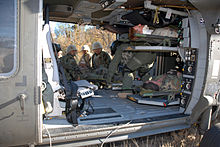
Picture - Aeromedical configuration
Performance
Never exceed speed: 193 knots (222 mph, 357 km/h)
Maximum speed: 159 kn (183 mph, 295 km/h)
Cruise speed: 150 kn (173 mph, 278 km/h)
Combat radius: 368 mi (320 nmi, 592 km)
Ferry range: 1,380 mi (1,200 nmi, 2,220 km) with ESSS stub wings and external tanks
Service ceiling: 19,000 ft (5,790 m)
Rate of climb: 700 ft/min (3.6 m/s)
Disc loading: 7.19 lb/ft² (35.4 kg/m²)
Power/mass: 0.192 hp/lb (158 W/kg)
Armament
Guns:
2 x— 7.62 mm (0.30 in) M240H machine guns or 2 x— 7.62 mm (0.30 in) M134 minigun or 2 x— .50 in (12.7 mm) GAU-19 gatling guns
2 x— 7.62 mm (0.30 in) M240H machine guns or
2 x— 7.62 mm (0.30 in) M134 minigun or
2 x— .50 in (12.7 mm) GAU-19 gatling guns
Can be equipped with VOLCANO minefield dispersal system. See UH-60 Armament Subsystems for more information.
ESSS stub wings can be equipped with:
70 mm (2.75 in) Hydra 70 rockets AGM-114 Hellfire laser guided missiles 7.62 mm (0.30 in), 20 mm (0.787 in), or 30 mm (1.18 in) M230 gunpods
70 mm (2.75 in) Hydra 70 rockets
AGM-114 Hellfire laser guided missiles
7.62 mm (0.30 in), 20 mm (0.787 in), or 30 mm (1.18 in) M230 gunpods
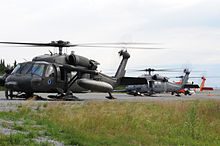
Picture - Army National Guard UH-60 Black Hawk with snow-ski kit
Black Hawk Down
Related development
Sikorsky S-70
Sikorsky HH-60 Pave Hawk
Sikorsky HH-60 Jayhawk
Sikorsky SH-60 Seahawk
Piasecki X-49
Comparable aircraft
Boeing-Vertol YUH-61
UH-1 Iroquois
Mil Mi-8/Mil Mi-17
NHI NH90
Footnotes
Citations
Bibliography
Bishop, Chris. Sikorsky UH-60 Black Hawk. Osprey, 2008. ISBN 978-1-84176852-6.
Leoni, Ray D. Black Hawk, The Story of a World Class Helicopter. American Institute of Aeronautics and Astronautics, 2007. ISBN 978-1-56347-918-2.
Tomajczyk, Stephen F. Black Hawk. MBI, 2003. ISBN 0-7603-1591-4.
Sikorsky UH-60 Black Hawk Pictures
More aircraft.
Source: WikiPedia